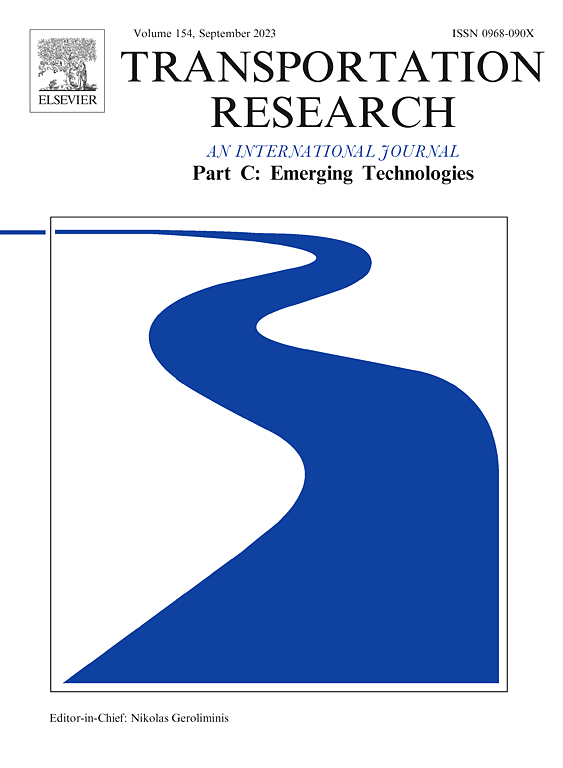Manage morning commute problem of household travels under single-step toll: A comparison study
IF 7.6
1区 工程技术
Q1 TRANSPORTATION SCIENCE & TECHNOLOGY
Transportation Research Part C-Emerging Technologies
Pub Date : 2025-03-06
DOI:10.1016/j.trc.2025.105075
引用次数: 0
Abstract
In general, road tolls could alleviate travel congestion for commuters during rush hour and improve the efficiency of individual transport trips. But for the household commuters, whether the road toll management framework can achieve the same effect is still unclear. From this perspective, it is meaningful to understand the difference between the impacts of road toll pricing on individual trips and on household trips. Based on this consideration, this paper investigates the influence of single-step toll strategy on household trips using the ADL model and the braking model. The optimal school-work time gap, optimal toll value and optimal toll interval are obtained for optimizing the total system travel cost. To have a deeper insight into the difference between the three types of models, the ADL, braking and Laih (Jia et al., 2016) models are studied extensively, leading to the following conclusions: (i) Under the optimal strategies in the three single-step household toll models, the optimal school-work time gap ranges and the toll intervals differ, but the optimal toll values are the same; (ii) The ADL model performs optimally in optimizing the total system travel cost, followed by the Laih model; (iii) the total congestion cost decreases with school-work time gap under the optimal strategy of the single-step toll models, and the ADL model performs optimally in this regard. Therefore, management insights can be derived, in which traffic authorities should set proper staggering hours, toll price and interval, as well as cultivate proper travel habits of household travelers, thereby helping to reduce road congestion and improve social welfare. Finally, a comparison of the three toll models through numerical experiments validates our findings.
单步收费下家庭出行晨间通勤管理问题的比较研究
一般来说,道路收费可以缓解通勤者在高峰时段的交通拥堵,提高个人交通出行的效率。但对于家庭通勤者来说,道路收费管理框架是否能达到同样的效果还不清楚。从这个角度来看,了解道路收费定价对个人出行和家庭出行影响的差异是有意义的。基于此,本文采用ADL模型和制动模型研究了单步收费策略对家庭出行的影响。得到了最优的课业时间间隔、最优的收费值和最优的收费间隔,以优化系统的总出行成本。为了更深入地了解三种模型之间的差异,本文对ADL、制动和Laih (Jia et al., 2016)模型进行了广泛的研究,得出以下结论:(i)在三种单步收费模型的最优策略下,最优课业时间间隔范围和收费间隔不同,但最优收费值相同;(ii) ADL模型在优化系统总行程成本方面表现最优,Laih模型次之;(3)在单步收费模型的最优策略下,总拥堵成本随课业时间间隔减小,且ADL模型在这方面表现最优。因此,可以得出管理见解,交通管理部门应该设置适当的错开时间、收费价格和间隔,培养家庭旅行者的良好出行习惯,从而有助于减少道路拥堵,提高社会福利。最后,通过数值实验对三种收费模式进行了比较,验证了我们的研究结果。
本文章由计算机程序翻译,如有差异,请以英文原文为准。
求助全文
约1分钟内获得全文
求助全文
来源期刊
CiteScore
15.80
自引率
12.00%
发文量
332
审稿时长
64 days
期刊介绍:
Transportation Research: Part C (TR_C) is dedicated to showcasing high-quality, scholarly research that delves into the development, applications, and implications of transportation systems and emerging technologies. Our focus lies not solely on individual technologies, but rather on their broader implications for the planning, design, operation, control, maintenance, and rehabilitation of transportation systems, services, and components. In essence, the intellectual core of the journal revolves around the transportation aspect rather than the technology itself. We actively encourage the integration of quantitative methods from diverse fields such as operations research, control systems, complex networks, computer science, and artificial intelligence. Join us in exploring the intersection of transportation systems and emerging technologies to drive innovation and progress in the field.

 求助内容:
求助内容: 应助结果提醒方式:
应助结果提醒方式:


